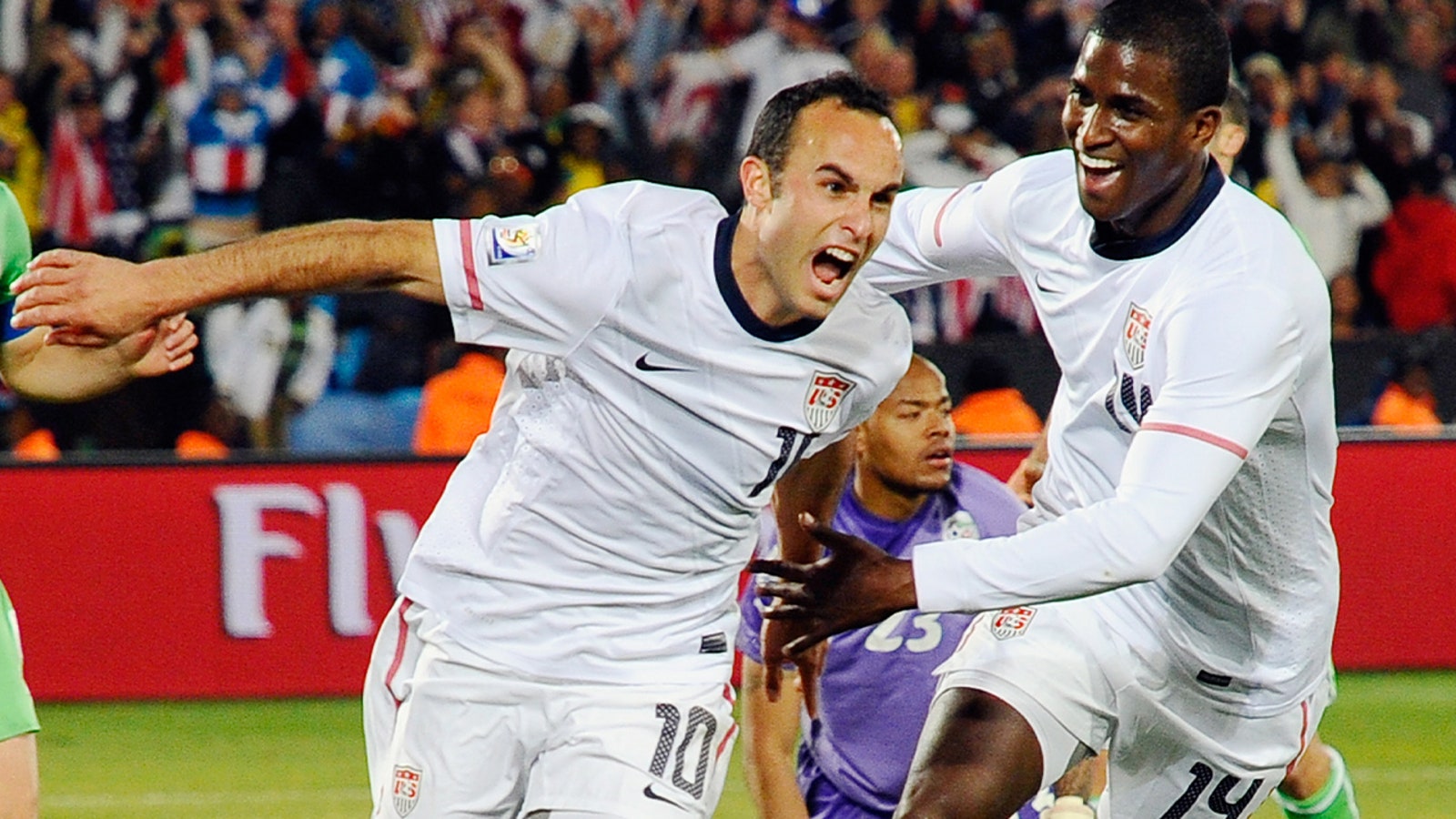Leadership within a locker room and on the field is sometimes difficult to identify or quantify because there are so many different forms of leadership: players that lead by example on the field with their performances, players that lead vocally, players that perform in big moments, players that don’t play a starring role but are good teammates within the locker room — all of these characteristics become an important part of the makeup of a successful team.
The United States men’s national team is no different.
In fact, if one were to look at past USMNT teams, and the leaders those teams possessed, they’d see a correlation. Let’s use the 2010 World Cup roster as an example.
In the United States’ group stage finale against Algeria, which came down to a last-minute goal from Landon Donovan, we started six different players that had captained teams at points in their careers:
- Carlos Bocanegra
- Landon Donovan
- Tim Howard
- Michael Bradley
- DaMarcus Beasley
- Steve Cherundolo
To their credit, almost all of those players got regular minutes and had important leadership roles at their clubs, which, A) gave them confidence and B) allowed that confidence to carry over to the national team. They ended up being incredibly important in big games.
They were the type of players that could influence a team’s momentum. They could pick you up when the team was down. They knew how to stay calm during the most hectic moments. They knew how to handle pressure, whether they were facing elimination against Algeria at the World Cup or going up against a Spain team on a 35-match unbeaten run in the Confederations Cup semifinals the year prior.
OTD: USMNT’s Landon Donovan scores last-minute MIRACLE goal against Algeria to advance in 2010 FIFA World Cup
Just over two decades later, in the qualifying stages of the 2022 World Cup, the USMNT fielded one of the youngest lineups in its history. Gregg Berhalter put a lot of trust in this young and talented group and opted to stay young, to allow these young players to grow into leadership roles within the team and find their own voice. He empowered them and throughout the campaign, we saw the predictable ups and downs, but many more good moments than bad.
The team went to the World Cup as the second-youngest team in the tournament and got out of the group with a win vs. Iran, a draw vs. Wales and an impressive draw vs. England. The signs were encouraging and the general belief was that this team would continue to get better heading towards 2026.
Fast-forward to 2024 and the Copa América. The USMNT went into the tournament with the vast majority of their important players having not played significant minutes with their clubs and not having important leadership roles within their teams. The results and performances were there for all to see: a group stage loss to Panama with a red card to Tim Weah, and then an underwhelming attacking performance vs. Uruguay.
The USMNT crashed out of the tournament, becoming the first host nation in the tournament’s history to not advance past the group stage.
Coming out of the tournament, one of my biggest criticisms of the current USMNT was the lack of leadership within the team. There just weren’t enough big characters within the team that could be captains on the field or come up with big moments for the team.
Tyler Adams, who captained the U.S. at the 2022 World Cup, is the team’s natural leader, but he played limited minutes in the tournament because of his injury and was massively missed in the midfield. Yunus Musah is not a leader on the field, nor is Gio Reyna — certainly not with his age (22) and the lack of minutes that he was getting at the time.
Tim Ream was about the only exception. Ream, 37, captained Fulham to a mid-table finish in the Premier League as their starting center back before joining the USMNT for Copa América. That experience as a leader benefited the U.S. during the tournament, but there was only so much he could do as one person leading the back line.
Ream’s former Fulham teammate, Antonee Robinson, played alongside him in the back line and was rock solid throughout the tournament with his performances, but is still on his way to becoming the type of figure that can lead at the national team level.
Now, things are starting to change.
On Sunday, Robinson captained Fulham for the first time in a 1-1 draw with Tottenham. He’s been a stalwart for Fulham all season, but now other players — and coaches, clearly — are starting to see that he’s capable of handling the armband, and that’s just going to continue to empower him.
Robinson isn’t the only USMNT player that has grown as a leader in just a few short months. Pulisic, who’s in the midst of a career season at AC Milan, has slowly grown into the idea of being a leader.
Pulisic has worn the armband for the USMNT in the past, but, I think, more so, because he’s been the team’s best player and, sometimes, in those situations, a coach knows the potential impact the star player has if he then becomes a leader.
Lionel Messi is a great example of this. He’s not the biggest vocal leader, though he’s grown a lot in that area over the years; he’s not going around doing these big, massive speeches for everyone to see; he’s not so animated when he’s on the field; but he’s a leader by example and performance captain. When he’s on the field, he produces this wonderful magic. Players around him look to him to come up with these big moments, and that’s where the leadership comes from.
Early in Pulisic’s career, I think there were elements of that, but more recently, I’ve been really impressed with his ability as a captain to take some ownership and show some leadership with the way he talks to the media, the way he leads the team on the field and the way he leads by performances.
Robinson and Pulisic’s rapid development as leaders can easily be traced back to them becoming bigger players at their clubs, and that’s the path forward for the other prominent names in the player pool.
Weston McKennie is now playing meaningful minutes at Juventus — can he grow more confident at the club level and a little bit more mature as a player to be a leader for the U.S. that can be counted on as more than just a guy that’s going to jump in and fight and be physically aggressive? He’s shown that he’s able to stick up for his teammates and he can lead in that type of way, but can he be a calming influence as well for this team?
There’s also Chris Richards. He’s been a bit unlucky with injuries at Crystal Palace, but I think, as a player, if he can find his voice, he could be a guy that could lead from the back, either alongside or in place of Ream. Because if you don’t have Ream back there in 2026, who is that big, commanding center back?
When you think about some of the best teams and countries in the world, they have these imposing center backs— Virgil Van Dijk with the Netherlands and Rúben Dias with Portugal — that are leaders in the back. They organize the team, they intimidate opponents. Can Richards develop into that type of role?
Then there’s Yunus Musah, who’s getting more regular minutes at his club; Tim Weah, who’s becoming an important player at Juventus; and Ricardo Pepi, who’s scoring a lot of goals at PSV.
Each player’s individual attributes of skill and counting stats are important, of course, and we, as fans of the game and analysts, love to obsess over those qualities. But the ability to step up and lead in big moments is also a skill, and arguably has a bigger impact on a game-to-game basis, but isn’t talked about nearly as much.
The good news is that the blueprint is there; the onus is now on the players to establish themselves more at their club, to take on bigger roles and make bigger impacts, and hope that it translates to the national team. The USMNT needs to have a much better and more experienced core leadership group heading into the 2026 World Cup — we’ll see who steps up.
Stu Holden, a former midfielder for the United States men’s national team, is FOX Sports’ lead match analyst for its marquee soccer coverage.

Get more from United States Follow your favorites to get information about games, news and more





























+ There are no comments
Add yours